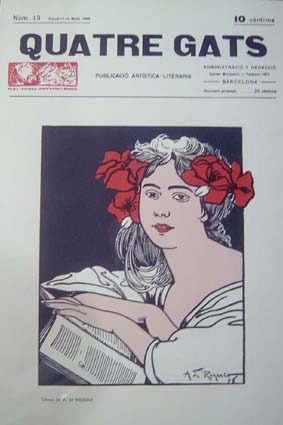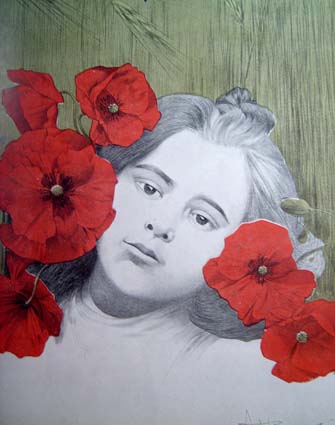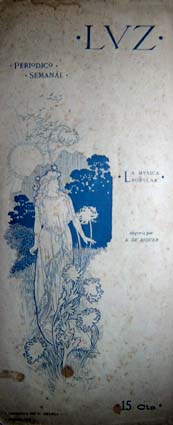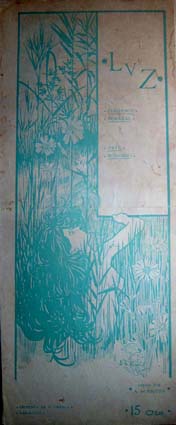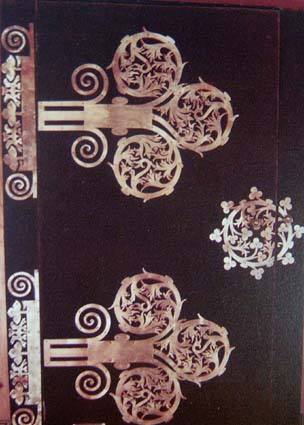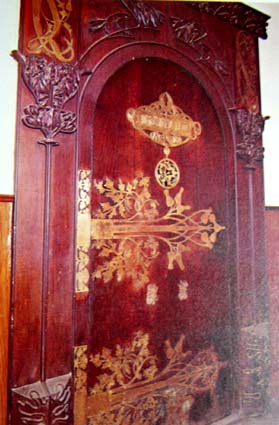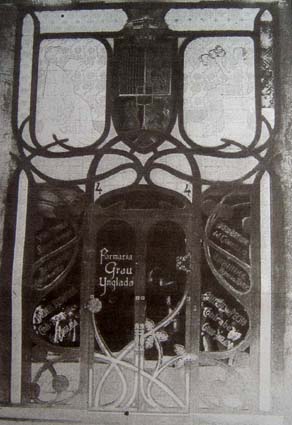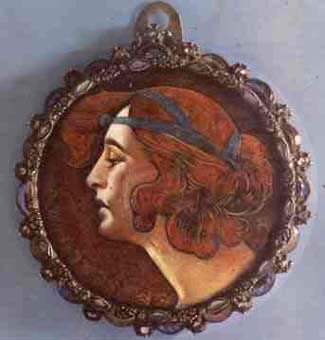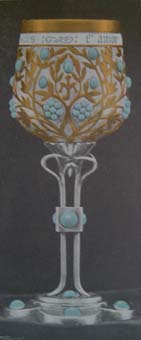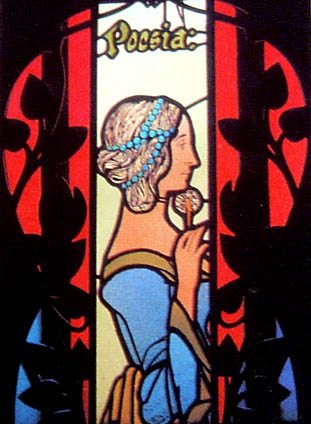Alexandre de Riquer i Ynglada (1856-1920) Other Pursuits
On Alexandre de Riquer:
—Biography —Posters —Interiors decoration —Bookplates—Literature —Painting —Other pursuits
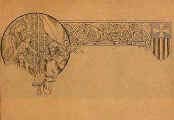
Other pursuits:
Drawing
List of works:
-Caplletra A (per “Maria” de J. Isaacs – 1883) – Initial letter A (for “Maria” of J. Isaacs) – (1883)
-El camí de la muntanya (per a “Maria” de J. Isaacs) – The mountain path (for “Maria of J.Isaacs) – (1883)
-Caplletra Q – Initial letter Q – (1889)
-Bosc – Wood – (1892)
-Gerro per realitzar en majòlica – Vase to be manufactured in ceramics – (1892)
-La casa pairal de Bassols
– El conillet -The Bassols house – (1894)
-Petita historia trista – Little sad history – (1896)
-Orla amb motius florals i animals – Border with floral and animal themes – (1895)
-Motius florals (4) (per “Crisantemes” – Floral themes ($) (for “Crisantemes”)
– 1897/98)
-Paisatge nocturn amb lluna (per a “Crisantemes”) – Nocturne landscape with moon (for Crisantemes)
– (1900)
-Projecte per al Institut Industrial de Terrassa
– Project for the Terrassa Industrial Institute – (1901)
-Editorial brand of the review l’Avenç – (1902)
-Segell per a l’Exposició d’Art antic (1902)
-Estudi d’ocells – Birds study – (1903)
-Esbossos – Sketches – (1905)
-Josefina de Riquer i Ynglada (1909)
-Auto caricature: “Finis grazias voviscu”
-Casa Garcia Viver (Poster sketch)
-Clar de bosc – Clearing –
-Detall d’un arbre – Detail of a tree –
-Dibuixos per estampació tèxtil – Drawings for textile industrial printing –
-Dues nimfes -Two Nymphs –
-Flors – Flowers –
-La sembradora – The sow woman –
-La vida a Bassols – The life at Bassols –
-La violinista – The violinist –
-Maternitat Maternity –
-Original per al segell de “Solidaritat Catalana” – Original sketch for the seal of “Solidaritat Catalana” –
-Santa Maria – The virgin Mary –
-Set vinyetes amb sol ocell i caragol – Seven vignettes with sun. bird and snail
–
-Tres dones – Three women –
-Tres esbossos per peces de joier – Three sketches for jeweller pieces –
-Verge amb nen i Guifré el Pilós – Virgin Mary with the child Jesus and Guifré el Pilós with the Catalonian four bars.
-Vetllades musicals selectes Perelló i Cia. – Musical soirées Perelló i Cia.
–
-Vita sine literis morts est”
Standards
List of works:
-Standard of “Unió catalanista” (Museu de Montserrat)
-Standard of l’Orfeó Català (Orfeó Català)
-Standard of Cercle Artístic de Sant Lluc (Centre Artístic de Sant Lluc)
*
Engravings
List of works:
-Figures femenines – Female figures – (MNAC)
-Dona asseguda al costat de l’aigua – Woman seated close to the water – (MNAC)
-Dona amb ocell – Woman with bird – (MNAC)
-Dona amb rosa – Woman with rose –
-Processó de Setmana Santa – Easter procession – (MNAC)
-Figura amb mantó – Figure with shawl – (MNAC)
-“Maja” amb guitarra – “Maja” with guitar -(MNAC)
-reparació d’ex-libris – Ex-libris sketch
.
-Poema – Poem –
-Diploma pel Primer Concurs d’Arts Industrials i Manifestació
Artística – Diploma for the first Industrial Art Competition and Artistic
Demonstration –
Illustrations
List of works:
-Yearbook annual of “La Il·lustració Catalana”
(1880)
-Portraits of dignitaries of “Jocs Florals” (1880)
-“Arte y Letras” Ink drawings (1882-1883)
-“Maria” de J. Isaacs (1882)
-“Los estudiants de Tolosa” (1886)
-“Para ellas” by Sánchez de Cantos Escobar (1896)
-Rinconete y Cortadillo by M. de Cervantes (1896)
-“Antología Americana” (1897)
-El Ídolo” by E. García Ladevese (1897)
-“La ciencia Moderna” byJulio Broutá (1897)
-“La perfecta casada” by Fray Luís de León (1898)
-Crisantemes” (1899)
Printed matters
Types:
-Dance cards
-Catalogues of expositions
-Invoices and commercial letters
-Greetings cards
-Invitations
-Commercial brands and labels
-Menus
-Artistic Postcards
-Programmes
-In memoriam and first communion cards
-Visit cards
-Financial titles, shares
Jewelry
Some works:
-Messalina (enamel, metal and precious stones of 6 cm. diam.)
-Alliance coup(for Masriera house 1902)
Playing cards Drawings:
-Pack of 48
Spanish cards for Guarro cny.
-Other drawings for the companies Guarro and Comas
Tapestries
List of works:
-La caça (The hunting)
-La pesca (The fishing)
Drawing was one of Riquer’s greatest talents and formed the basis of all of his artistic creations. His immense contribution to this field is dominated by the Art Nouveau aesthetic.
The list to the left (Drawing: List of works) contains some of his most representative works.
Aside from drawing, we consider other of Riquer’s specialties, such as illustration, engravings, textile design stamping, playing cards designed for the Guarro and Comas companies, book covers and illustrations.
Industrial textile design stamping:
The Museum of Printing in Premià de Mar (Maresme) has discovered seven textile stamping designs by Riquer. These designs come from the Ponsa Hermanos factory, which would seem to confirm that Riquer also worked for industry. Artistically, two strains appear: one naturalist and the other completely modernist, in which Riquer reveals himself at his most modern and most connected to international artistic movements. The third design (below) is the most spectacular and surprising; it reveals an abstract instinct not then current in Art Nouveau, except in the works of Gaudí and Jujol.
**Images published under authorization of “Museu de l’Estampació de Premià de Mar” (for the originals) and “Centre de Documentació i Museu Tèxtil de Terrassa” (for the photographs).
Playing cards: Riquer designed a plethora of packs of playing cards for various companies, such as Guarro, Comas, and others.
Many examples are now on display in the Fournier Company Museum in Vitoria-Gasteiz.
Playing cards of a Spanish pack for the company Guarro.
Magazine and book illustrations and covers:
According to Alexandre Cirici i Pellicer, Riquer considered illustrated books one of the jewels of the Art Nouveau era – whether he also wrote them himself or merely illustrated other author’s works.
Riquer, like all the great Art Nouveau artists, did not consider illustrations to be simple graphic representations of text, but rather to be profound fusions of text and image that intensified the expression and suggestive nature of idea and thought.
Work in wood:
Alexandre de Riquer also achieved enormous prestige with his artistic wood creations. Though he realized only a limited number of these projects, they were of a high technical and artistic quality.
In 1892, he founded a carpentry and decoration studio with his cousin, Manel de Riquer, on carrer Pau Claris, 38 in Barcelona.
Two years later, after a trip to London where he became acquainted with modern English decorative arts (the Arts and Crafts Movement), he fell under the influence of the pre-Raphaelites.
He then moved to carrer Freneria, where he established a house-workshop that operated until 1917. At this workshop, he trained several future decorative arts professionals, often without any monetary compensation.
Flags and tapestries:
Another of Alexandre de Riquer’s many artistic pursuits was the design of flags, then much en vogue in Catalonia, when they were then (and are still even today) symbols of organizations such as political parties, music societies, cultural institutions, literary circles, and so forth. Within the field of textile decoration, Riquer also developed an active interest in tapestries.
Jewelry: Riquer also dedicated himself to jewelry, designing pieces for the Masriera brothers and other jewelers in Barcelona and producing a number of high-quality works prized not only for the materials used, but also for their exquisite design. Among them are the Messalina medallion (left) and a chalice (right).
Wrought iron: There is no evidence that Riquer actually produced wrought iron pieces, but it is certain that he was an avid collector, particularly of objects from rural life.
Stained glass: At left is the window Riquer designed for the Cercle del Liceu, entitled “Poetry”.
He also had an important collection of antique glass works that is now on display at the Cau Ferrat Museum in Sitges.

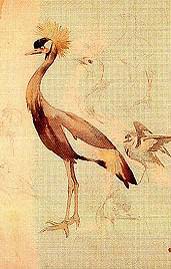
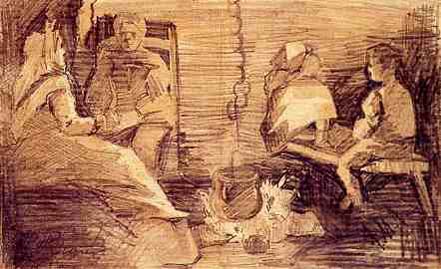

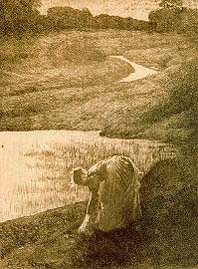
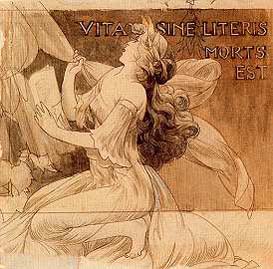
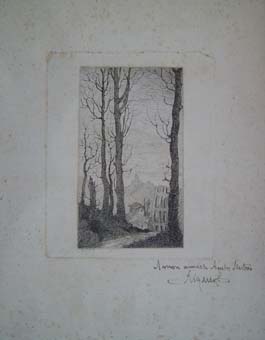
![Riquer ExL detall_V G de Paredes[1]r](http://www.gaudiallgaudi.com/wp-content/uploads/2017/07/Riquer-ExL-detall_V-G-de-Paredes1r-400x284.jpg)
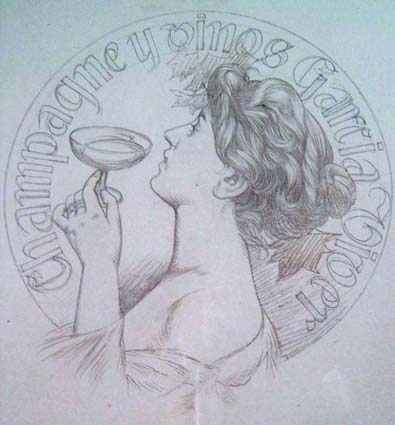
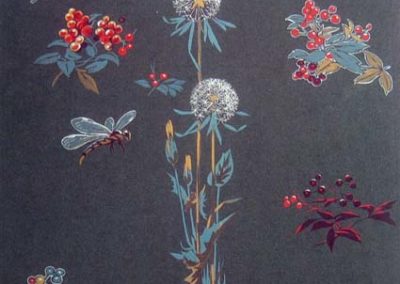
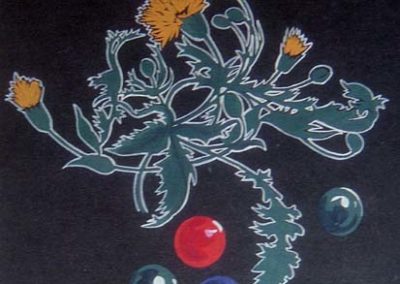
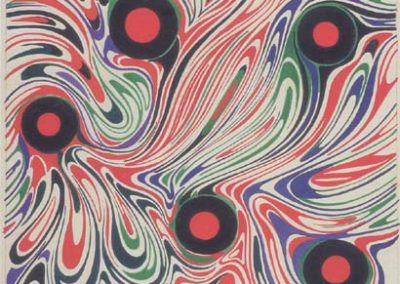
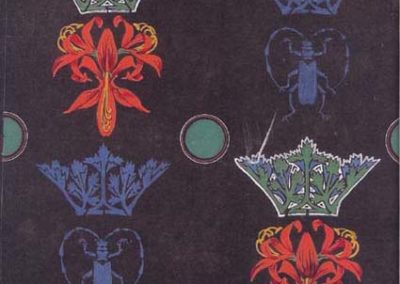
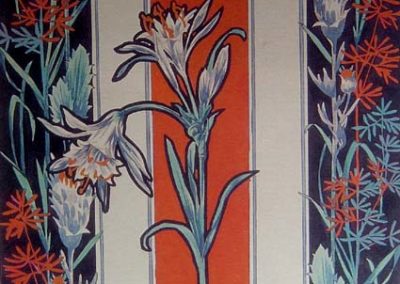
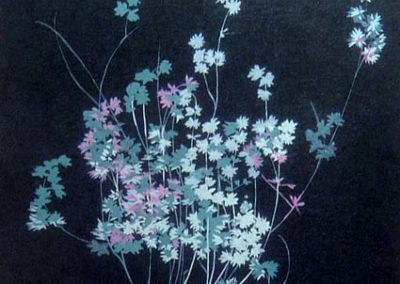
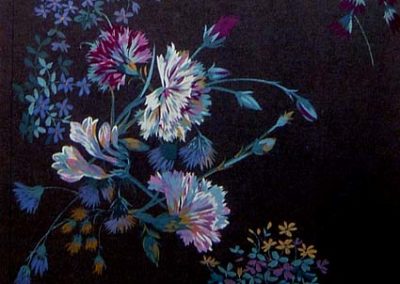
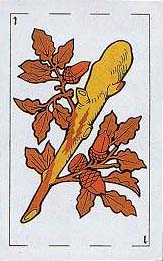
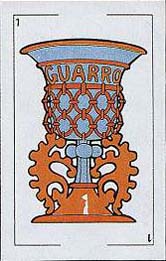
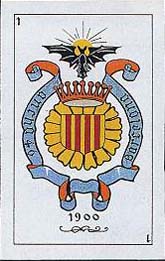
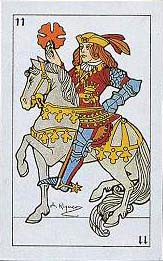
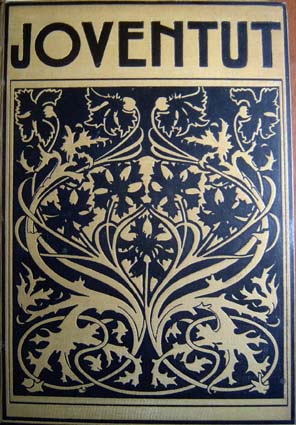
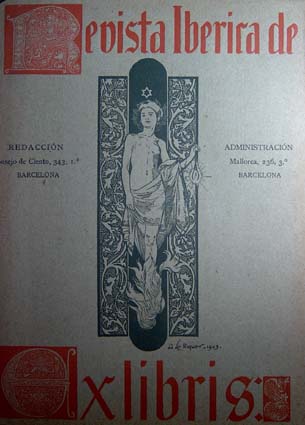
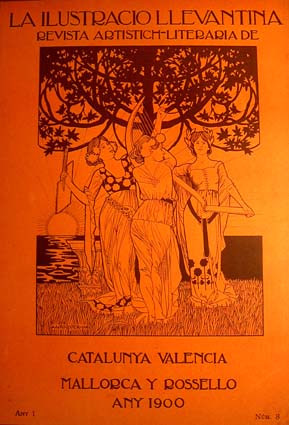
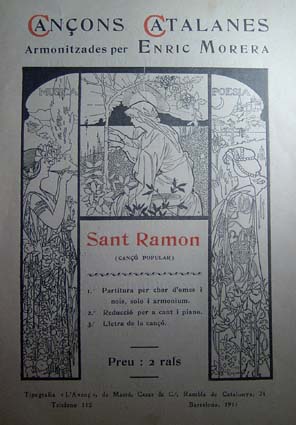
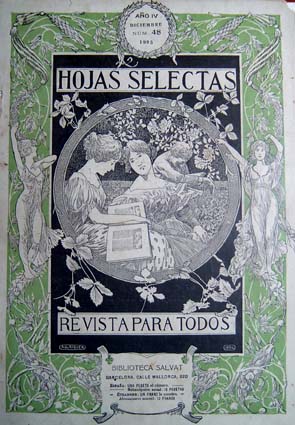
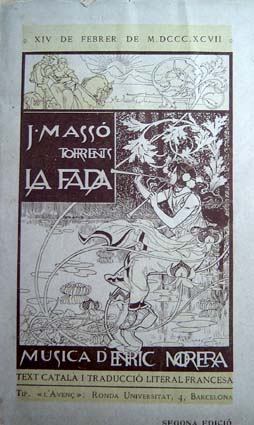
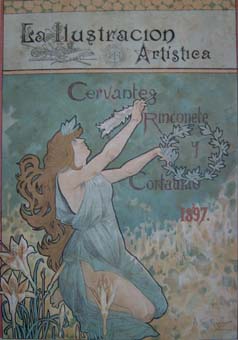
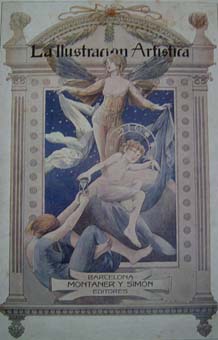
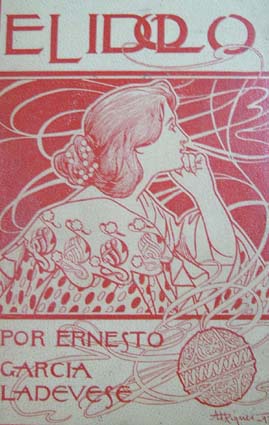
![Riquer Ilustracions anyorances2[1]r](http://www.gaudiallgaudi.com/wp-content/uploads/2017/07/Riquer-Ilustracions-anyorances21r.jpg)
![Riquer Ilustracions Aplech_de_sonets2[1]r](http://www.gaudiallgaudi.com/wp-content/uploads/2017/07/Riquer-Ilustracions-Aplech_de_sonets21r.jpg)
![Riquer Ilustracions Crisantemes2[1]r](http://www.gaudiallgaudi.com/wp-content/uploads/2017/07/Riquer-Ilustracions-Crisantemes21r.jpg)
![Riquer Ilustracions Crisantemes_il2[1]r](http://www.gaudiallgaudi.com/wp-content/uploads/2017/07/Riquer-Ilustracions-Crisantemes_il21r.jpg)
![Riquer Ilustracions Quan_jo_era_noy2[1] r](http://www.gaudiallgaudi.com/wp-content/uploads/2017/07/Riquer-Ilustracions-Quan_jo_era_noy21-r.jpg)
![Riquer Ilustracions Poesies2[1] r](http://www.gaudiallgaudi.com/wp-content/uploads/2017/07/Riquer-Ilustracions-Poesies21-r.jpg)
![Riquer Ilustracions Los_estudiants_de_TOLOSA2[1]r](http://www.gaudiallgaudi.com/wp-content/uploads/2017/07/Riquer-Ilustracions-Los_estudiants_de_TOLOSA21r.jpg)
